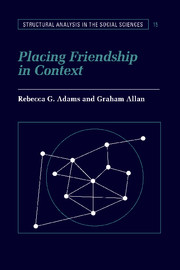Book contents
- Frontmatter
- Contents
- Notes on the contributors
- Acknowledgements
- 1 Contextualising friendship
- 2 The modernisation of friendship: individualism, intimacy, and gender in the nineteenth century
- 3 The gendered contexts of inclusive intimacy: the Hawthorne women at work and home
- 4 Friendship and the private sphere
- 5 Rich friendships, affluent friends: middle-class practices of friendship
- 6 Women's friendships in a post-modern world
- 7 Foci of activity as changing contexts for friendship
- 8 The demise of territorial determinism: online friendships
- 9 Reflections on context
- Index
- Structural Analysis in the Social Sciences
9 - Reflections on context
Published online by Cambridge University Press: 15 December 2009
- Frontmatter
- Contents
- Notes on the contributors
- Acknowledgements
- 1 Contextualising friendship
- 2 The modernisation of friendship: individualism, intimacy, and gender in the nineteenth century
- 3 The gendered contexts of inclusive intimacy: the Hawthorne women at work and home
- 4 Friendship and the private sphere
- 5 Rich friendships, affluent friends: middle-class practices of friendship
- 6 Women's friendships in a post-modern world
- 7 Foci of activity as changing contexts for friendship
- 8 The demise of territorial determinism: online friendships
- 9 Reflections on context
- Index
- Structural Analysis in the Social Sciences
Summary
If nothing else, the chapters in this book have demonstrated that friendships take a variety of different forms. More importantly, they have illustrated that these various forms do not arise haphazardly nor solely as a result of individual motivation. Like all personal relationships, even when they appear to those involved to be dyadic constructions – an expression of their own personalities, interests, and creativity – they are none the less shaped by contextual factors that lie outside the direct control of particular individuals. Thus, the close friendships analysed by Oliker in chapter 2 not only differed from those Marks examined in chapter 3 and the ones Harrison considered in chapter 5, but did so in ways which become understandable once they are located within the contexts in which they were developed. Each of these forms of friendship involved women sharing intimacies, but the ways in which this was done and the character of the intimacies shared varied as a result of the different worlds these women occupied.
More generally, the papers in this collection highlight the degree to which friendships are contextually embedded. How friendships are organised, their content, and the boundaries implicitly placed around them are all shaped by the characteristics of both the individuals and their interactional locations. Not only does the historic social and economic context inform the patterning of friendship, but so too the friendships people generate are indubitably influenced by their own structural positions. This point, first developed by Hess (1972), is an important one.
- Type
- Chapter
- Information
- Placing Friendship in Context , pp. 183 - 194Publisher: Cambridge University PressPrint publication year: 1999
- 2
- Cited by

